Fractal Design Define XL R2 Case Review: Maybe We Can Have It All?
by Dustin Sklavos on February 20, 2013 12:01 PM EST- Posted in
- Cases/Cooling/PSUs
- quiet
- Fractal Design
- ATX
Noise and Thermal Testing
I went into testing the Fractal Design Define XL R2 feeling a little skeptical. The Define R4 wasn't a bad case by any stretch of the imagination, but it was an underwhelming one, and it was pretty swiftly eclipsed by Nanoxia's Deep Silence case designs. That in mind, I didn't think the XL R2 would be a poor case, but it needed to be more than an also-ran and it needed to clear the same hurdle every other quiet case must: it had to provide good thermal performance.
Per usual testing procedures, the XL R2 was tested with the middle drive cage removed, and tested at each fan setting available. Ambient temperature during testing was ~22C.
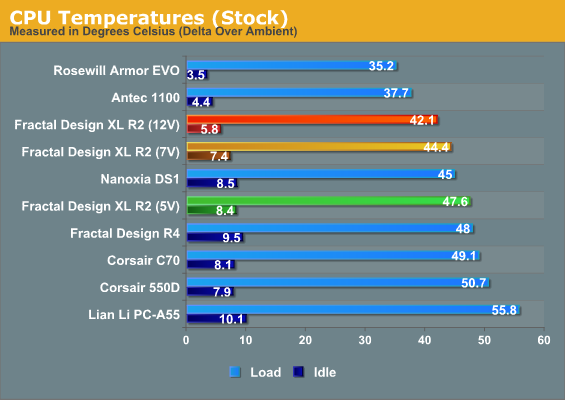
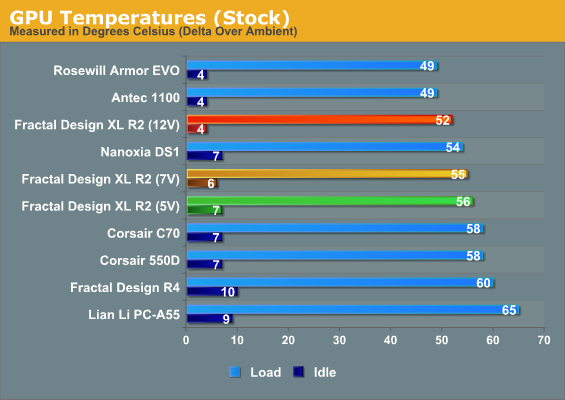
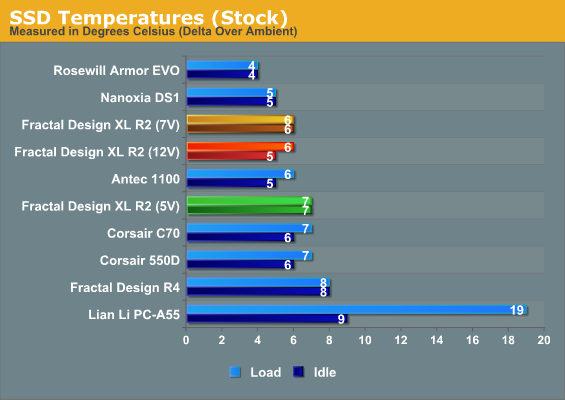
Stock thermals weren't stellar, but they were remarkably competitive. The XL R2 defeats the R4 and is capable of meeting or beating Nanoxia's Deep Silence 1.
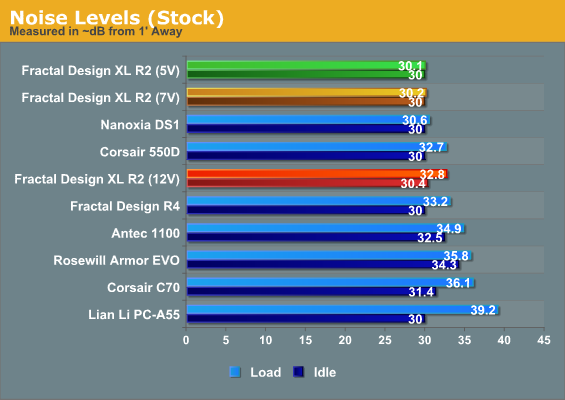
Noise levels are also nearly perfect. The XL R2 is a quiet case and, at least in our stock configuration, is able to pull good thermal performance out of low acoustics.
So far, so good. The XL R2 isn't mind-blowing but it's definitely competitive. As it turns out, though, there's a lot more fight left in the XL R2 than would first appear.
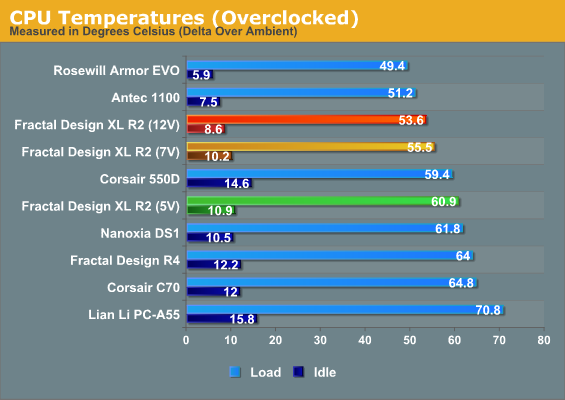
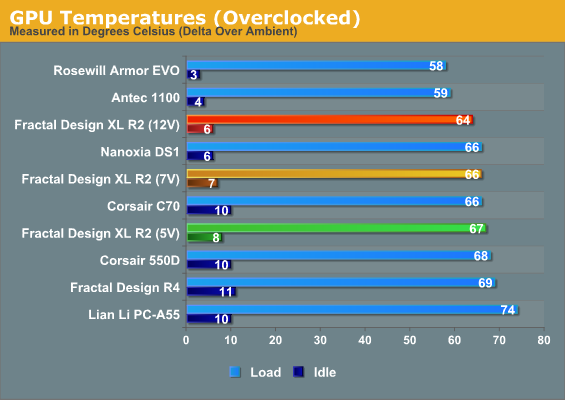
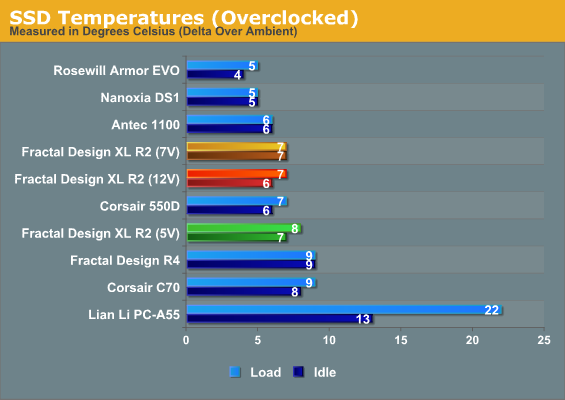
The overclocked testbed usually buries quiet cases, but the XL R2 holds its own. At worst, it's competitive with Nanoxia's formerly class-leading Deep Silence 1. At best, it eclipses it soundly.

Speaking of sound, the XL R2 is also capable of running at roughly the same sound levels as Nanoxia's case while performing at least as well, if not better. It's true that Fractal Design's case does benefit from a larger footprint, but this is still a pleasant surprise to see.










46 Comments
View All Comments
ymrtech - Wednesday, February 20, 2013 - link
I have the first version of the XL and I love it.Gigantic, but quiet as hell when combined with aftermarket 120mm GPU (x2) fans and a Noctua nd-h14.
My fans never increase in speeds, even under load, and the temperatures are always low.
reemrevnivek - Wednesday, February 20, 2013 - link
You wrote:> Unfortunately, installing a full size hard drive into the top slot
> of the cage will result in it scraping against the bottoms of the
> plastic pegs that allow for the rotatable cage mounts.
I just got this case (and agree with most all of the review) but this wasn't a problem I encountered. I installed a WD Caviar Blue 1TB hard drive and had no such troubles. I slipped the drive sled out, turned the mounting screws in securely, and slid it back in. Turning down the mounting screws caused just a bit of compression on the rubber grommets, but not enough to allow the drive to interfere and break off a plastic peg. The spec sheet for your Deskstar drive says it's the same height (26.1mm/1.028") as the WD drive, which is pretty standard.
With these two data points, I am suspicious that the pegs were somehow moved in your removal and re-installation of the drive cages, and this is one of . Could you check this? I'll make measurements of the clearances on my case when I get home tonight for comparison.
arthur449 - Wednesday, February 20, 2013 - link
I encountered this problem recently with WD Red 3TB drives and a Fractal Design Arc Midi. Care had to be taken when inserting 3.5" drives into the cage or the screws of the drive above would scrape the top of the drive below.arthur449 - Wednesday, February 20, 2013 - link
Apologies for the double reply, but it should be stated that I had the same issue with Samsung F4s, WD Greens, and ancient Seagate 7200.11s. I screwed the mounting screws in as tight as they would go, causing your noted compression on the rubber grommets, but it still didn't give me the clearance needed to insert a drive beneath another without manually lifting the drive in the tray above when inserting the drive beneath.rrohbeck - Wednesday, February 20, 2013 - link
Stupid question, but did you use the right screws? I never had that problem mounting 9 drives in my Define XL.arthur449 - Wednesday, February 20, 2013 - link
It's entirely possible that the Arc Midi has less space between the drive trays than the Define XL, but I'm glad to see at least someone else is having clearance issues with 3.5" drives and Fractal Design cases.I only mounted seven 3.5" drives in the Arc Midi, but I double and triple checked that the screw placement and grommets were properly attached to the trays and that the screws were threaded as far into the drives as they would go (however, the threads of the included wafer head screws stopped well shy of the depth available in the HDD housing.)
Perhaps this is simply an issue with the screws provided with the case.
reemrevnivek - Wednesday, February 20, 2013 - link
The threads of the wafer head screws were able to go completely into my three assorted drives. They've got 0.2" of thread and a 0.2" shank. The drives all have at least 0.25" of thread depth, and the wafer head screws seat at the shank, which slides through the bushing providing vibration isolation. Do you have threads exposed when there's a bushing on the shank?reemrevnivek - Wednesday, February 20, 2013 - link
OK, the promised measurements:- Sled metal + paint thickness: 0.030"
- Height of grommet + sled metal + screw head*: 0.247"
- Delta between fingertight mount screws and torqued down hard: 0.021" (reduces above height to 0.226)
Maximum drive thicknesses:
- Hitachi HDT721075 SLA 360: 0.993"
- Seagate Barracuda 7200.11 750 GB: 1.017"
- Western Digital Caviar Blue WD10EALX: 1.011"
Drive + sled thickness:
- Hitachi HDT721075 SLA 360: 1.227"
- Seagate Barracuda 7200.11 750 GB: 1.248"
- Western Digital Caviar Blue WD10EALX: 1.233"
*These aren't precisely 0.021 + drive height, but I didn't do a thorough statistical sampling of each corner of each drive...it's close.
And the most important measurements:
- Inter-sled spacing: 1.254", +/- 0.02" over all 8 drive sleds
- Grommet to plastic spacer (top hard drive max height): 1.017"
It looks like I was simply lucky to have a set of drives and cages that fit well. My original comment was posted from work based on recollection of yesterday's assembly. As an electrical engineer with a little bit of mechanical design experience, the tolerance levels I see here aren't sufficient for a sheet metal manufacturing process, especially when you add painting/powder-coating variance into the mix.
Looks like this is a tiny manufacturing oversight by Fractal Design, it was manufactured to use 1" high drives (they're not all precisely 1", 26.1mm is fairly common) and 0.25" thick grommets and wafer head screws, requiring 1.25" of spacing between sleds. This really needs to include some extra spacing for manufacturing errors, clearance fitting for easy assembly, and air flow here wouldn't hurt drive temps either.
(PS: "and this is one of ." was supposed to be "and this is one of the things I didn't do." in the previous comment. I have now installed and removed the cages, and unless the whole cage was bent in your extraction (unlikely), it seems impossible to change the thickness.)
Vatharian - Wednesday, February 20, 2013 - link
That was nice review, but I'm sorry, it lacks something: What's the point of testing mediocre (in terms of noise output and required/generated airflow) system in such big case? It is valid of course, as it gives reference point, but it's not so useful without a comparison. And that would be fitting at least full ATX, or yet better EATX (to test clearances for cable management in cases that support it (it's easy to route cables if you're putting mini-ITX board in CosmosS, like I did some time ago), with a couple or trio of loud (470 or 5850? FX-5950XT :D). Old 920-equipped X58 or some AM3 130W-140W Phenom I/II with three 470s or 5850, couple of 7.2k rpm drives and stock intel/AMD cooler, as a noise dampening torture test, and then a reasonable system (what was tested here is quite good), that's what should be done with every case. Purpose: It will give idea how good the case is in range of systems (interpolation, yo!), and when choosing a case, we get wider array of features we can compare. What's the cheapest case out there? Which is the quietest case? Which one is best for effectively cooling my high-end hardware? Which has the most useful-to-me feature-rich case, or with highest build quality? And, my favorite: What's the cheapest (with acceptable aesthetics, as per taste) case that will quietly house my hardware? That's why two sets of hardware should be included in case tests.Sabresiberian - Wednesday, February 20, 2013 - link
I agree; a huge case like this isn't really for the guy who builds a standard rig, it's for the person intending to fill it with a large MB loaded with graphics cards. At least one of the cards known to be rather noisy would be a better test here.And, I still want to know if the case will actually hold an XL-ATX comfortably, if it claims to be able to. You don't need to run the whole test with a board you can't fit in smaller cases, just put a couple of screws in it to see if it actually fits in, and if you have to do something like move the PSU from a bottom to top mount.
I don't want to make this sound too negative - Anandtech does a great job with case reviews! These are just suggestions for ways to improve a bit. :)